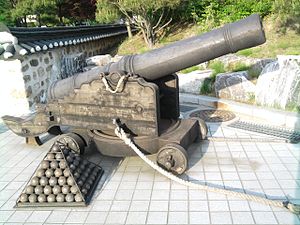Hongyipao
| Hongyipao | |
|---|---|

Hongyipao displayed at Hwaseong Fortress
|
|
| Type | Smoothbore muzzle-loading culverin |
| Place of origin |
|
| Service history | |
| In service | Early 17th – late 19th centuries |
| Used by |
Ming dynasty |
| Wars |
Manchu conquest of China United States expedition to Korea Ganghwa Island incident |
| Production history | |
| Produced | 17th to 19th centuries |
| Specifications | |
| Weight | 1800 kg |
| Length | 2.15 m |
|
|
|
| Caliber | 12 cm |
| Barrels | 1 |
| Effective firing range | 700 m |
| Maximum firing range | 2-5 km |
Hongyipao (Chinese: 紅夷炮; pinyin: hóngyípào; literally: "red barbarian cannon"; Hangul: 홍이포; RR: hong-ipo) was the Chinese name for European style muzzle-loading cannons introduced to China and Korea from the Portuguese colony of Macau and by the Hendrick Hamel expedition to Joseon in the early 17th century.
The term "red barbarian cannon" derives from the weapons' supposed Dutch origins, as the Dutch were called "red haired barbarians" in southern China. However, the cannons were originally produced by the Portuguese at Macau, with the exception of two cannons dredged up from a Dutch ship in 1621. The Dutch ship may have been in fact an English ship and the cannons had English coats of arms. The English ship Unicorn sank near Macau.
The Jurchens renamed the "red barbarian cannon" to "red coat cannon" (Chinese: 紅衣炮; pinyin: hóngyīpào) when it entered their arsenal because they found the term "barbarian" to be insulting, and were known as such in the Manchu Eight Banners.
Breech loading swivel cannons from Portugal entered the Chinese weaponry after a Ming fleet defeated the Portuguese at the Battle of Xicaowan in 1521 and captured their guns as war booty. However it's possible that individuals in China had been able to purchase Portuguese style cannons even earlier from pirates.
After the Ming dynasty suffered a series of defeats against the Later Jin, they contacted the Portuguese in Macau to have iron cannons made for them. Attempts were made to bring Portuguese gunners to the north as well, but they were repeatedly turned away because Chinese officials harbored suspicions against them.Yu Zigao, commander of Zhejiang and Fujian, ordered several "red-barbarian cannon" in 1624 prior to his expedition against the Dutch outpost on Penghu Island in the Pescadores.
...
Wikipedia
